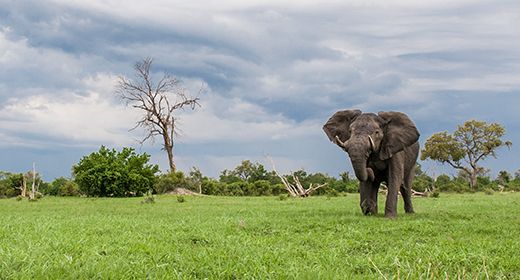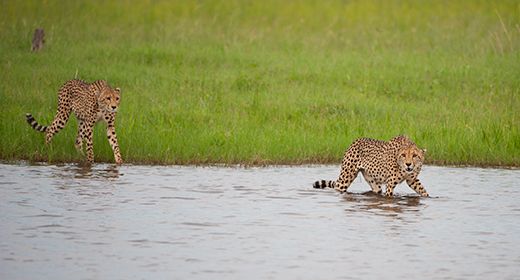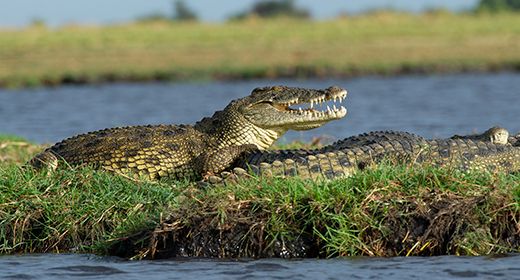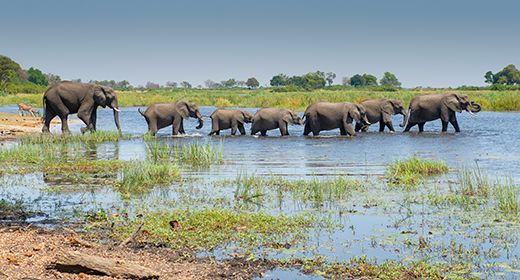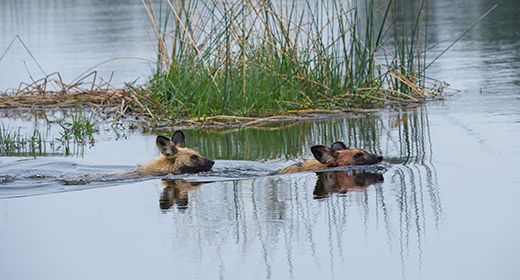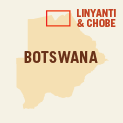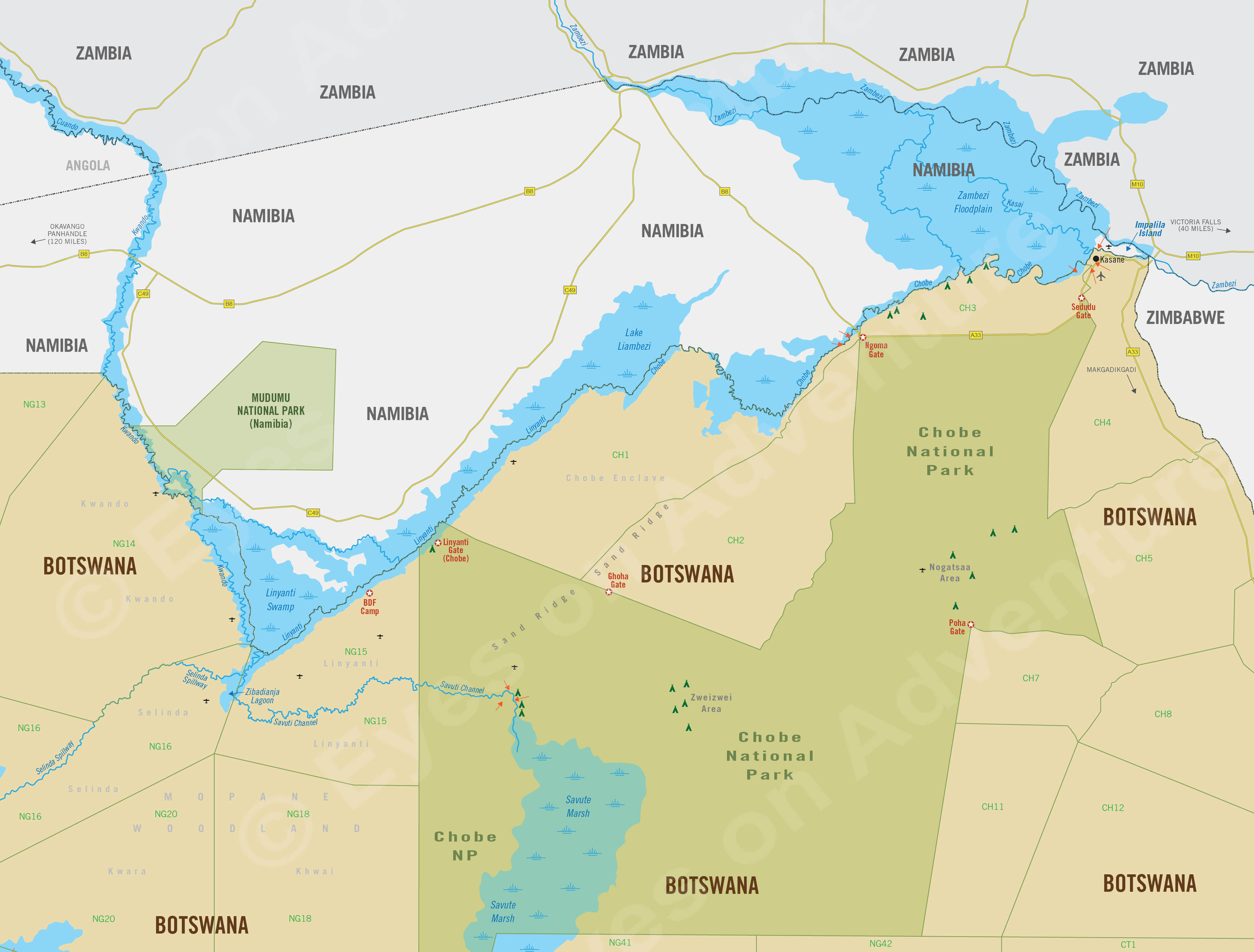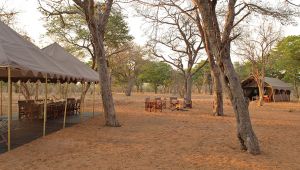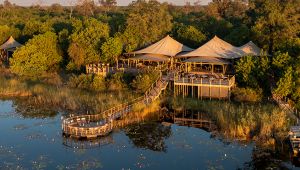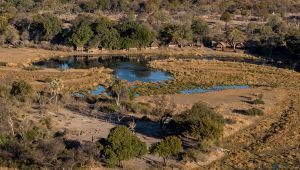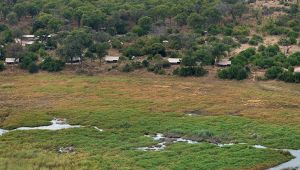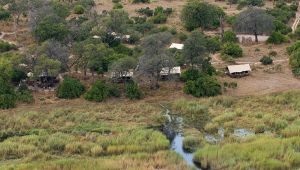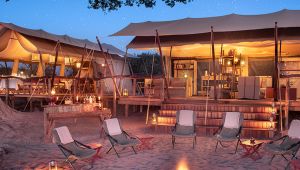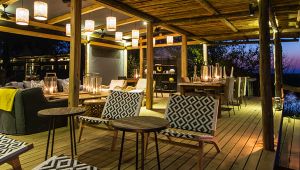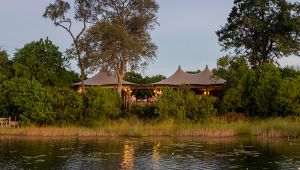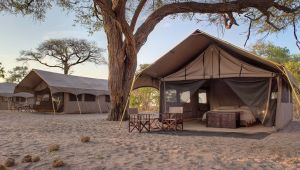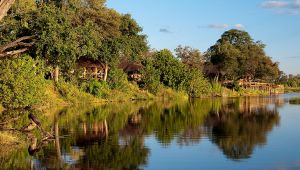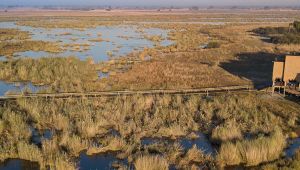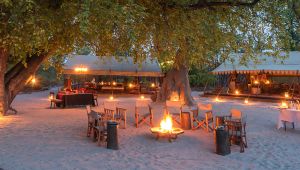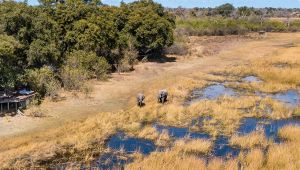Linyanti & Chobe
(incl. Kwando, Selinda, Savuti Channel, Savute Marsh, Chobe River, Chobe NP)
Region Links: Central Kalahari, Linyanti & Chobe, Makgadikgadi, Okavango Delta, Okavango Panhandle, Tuli Block
Highlights
- Combine with Okavango Delta to create a diverse safari experience.
- Boating safari on the Chobe River to watch elephants swimming.
- The Savuti Channel is one of Botswana's premier wildlife destinations.
- The Savute Marsh in Chobe National Park for big prides of lions.
EOA Recommends: DumaTau Camp, Lebala Camp, Linyanti Bush Camp, Selinda Camp, Zarafa Camp
Bordering the Okavango on the north, the large ecosystem consisting of the Linyanti / Selinda / Kwando Reserves offers a similar experience to the Okavango, with superb wildlife and pristine wilderness. Chobe National Park offers additional safaris to the east.
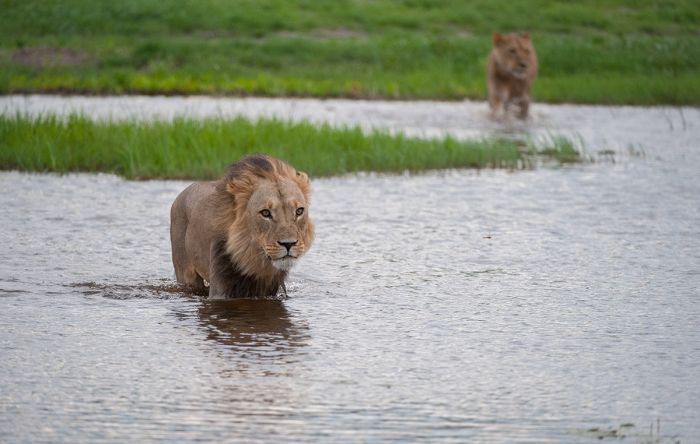
Lions crossing flood water in the Savuti Channel (Copyright © James Weis).
Game viewing in the Linyanti/Selinda/Kwando is excellent and the lodges and camps are few and far between, offering an exclusive safari experience.
To the east is Chobe National Park, which encompasses additional wilderness and wildlife, as well as Chobe River safaris.
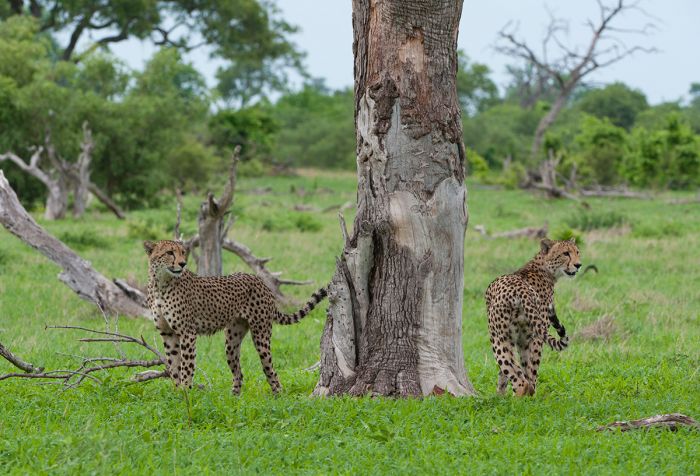
Cheetah brothers in the Savuti Channel (Copyright © James Weis).
The Linyanti, Selinda and Kwando Reserves are home to elephant, buffalo, lion, leopard, cheetah, African wild dog, spotted hyena, giraffe, zebra and other plains game - all present in abundance. Lesser-seen species like sable and roan antelope are also here.
The three reserves are all privately managed and off-road driving is permitted, as well as night drives. The safari camps are superb and guests enjoy large, protected areas and diverse habitats on their game-viewing activities.
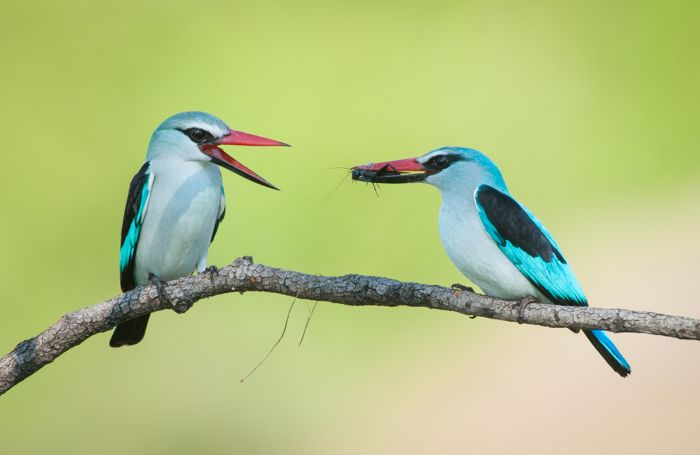
Woodland kingfishers in the Linyanti Reserve (Copyright © James Weis).
These three reserves border the Okavango to the south and the country's boundary with the Caprivi of Namibia to the north. The Linyanti Swamp, fed by the Kwando River is like a miniature Okavango Delta and out of the swamp, the Savuti Channel flows eastward to the Savuti Marsh in Chobe.
Chobe National Park is located east of the northern reserves and is mostly a dry habitat other than the Savute Marsh, which is fed by water from the Savuti Channel. Chobe also offers some very affordable overland safaris and public campsites.
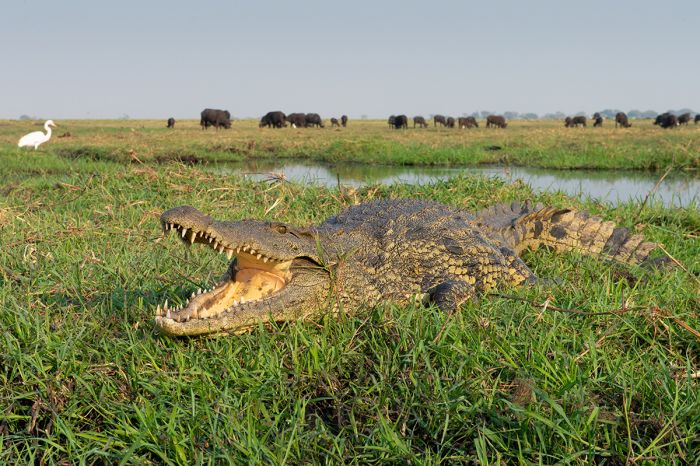
Crocodile and buffalos on the Chobe River (Copyright © James Weis).
The Chobe River forms the northern boundary of Chobe National Park and safaris here, especially during the dry season, are exceptionally productive. Large herds of elephants congregate here for the water, as do healthy numbers of buffalo, hippo, crocodile, kudu, red lechwe and other plains game. Lion, leopard, and wild dog are also regularly seen.
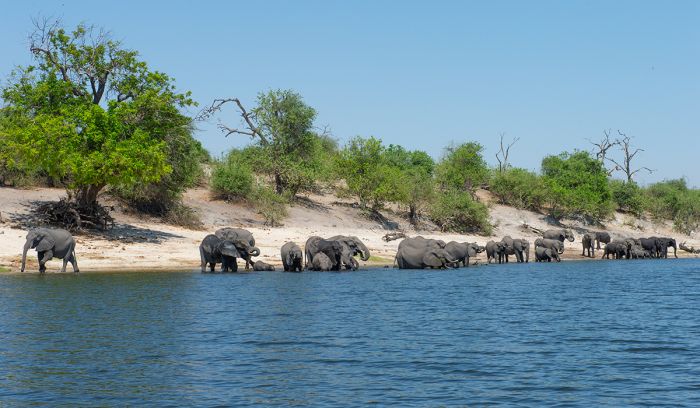
Elephants drinking along the Chobe River (Copyright © James Weis).
Safaris that combine some days in the Okavango Delta with days in this northern region are very popular. The Victoria Falls are only a short distance from Chobe and visitors often include a visit to The Falls at the end of their safaris.
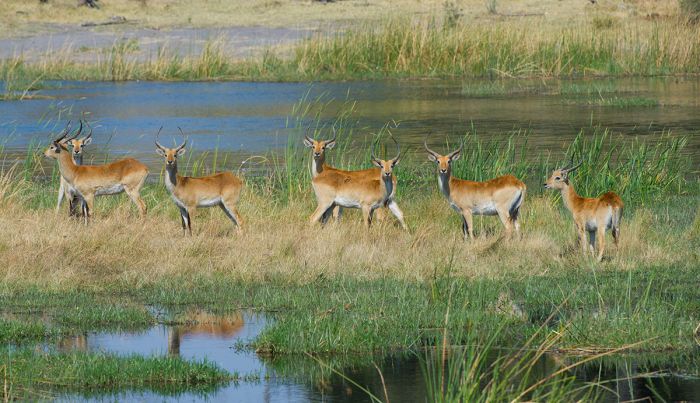
Red lechwe antelopes along the Linyanti River (Copyright © James Weis).
Read More...
Chobe National Park, Chobe Riverfront, Kwando, Linyanti, Northern Reserves, Savute Marsh, Selinda
Northern Reserves
Located directly north of the Okavango Delta are three superb wildlife reserves: the Linyanti, Selinda, and Kwando. All three reserves offer superb game viewing in huge wilderness areas with very low tourist numbers.
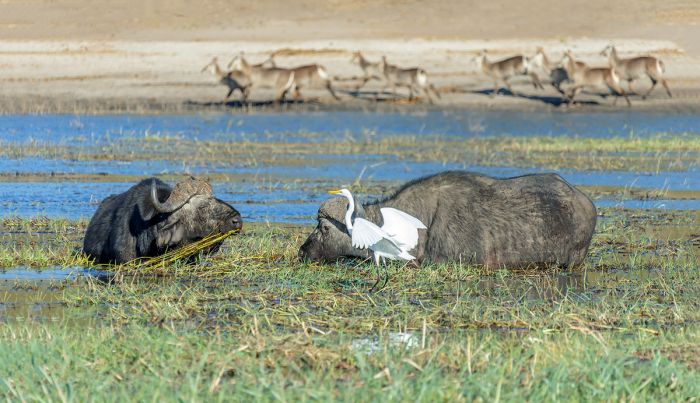
Two bull buffalos in the Chobe River with a herd of waterbuck on the shore.
The Kwando River flows south from Angola and, like the Okavango River to its west, it empties partially into the Kalahari sands here, creating a much smaller version of the Okavango Delta - called the Linyanti Swamp.
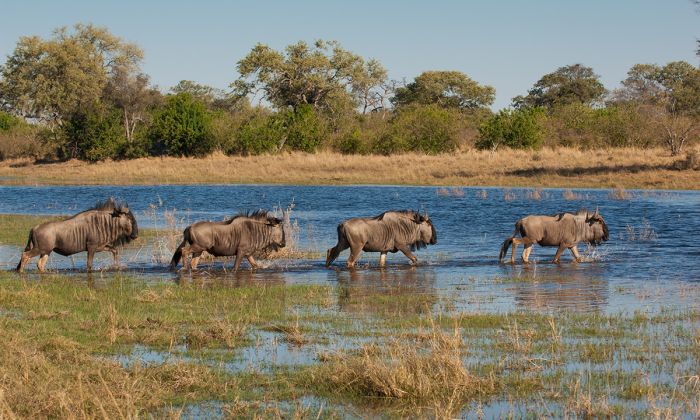
Wildebeests in the Linyanti Reserve (Copyright © James Weis).
In the 'bigger' flood years (when rains falling in the Angolan highlands are heavier), the Linyanti swamp overflows and feeds into the Savuti Channel (which flows all the way to Chobe National park and into the Savute Marsh) and the Selinda Spillway (which connects to the Okavango itself).
However, most of the Kwando River's water flows through the Linyanti Swamp and then east into the Linyanti River, which continues to the Chobe River and eventually over the Victoria Falls and out to the Indian Ocean.
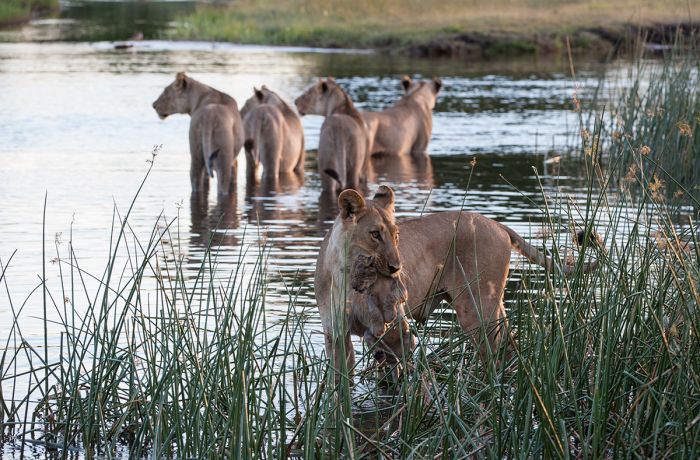
Lions in the Linyanti Reserve (Copyright © James Weis).
Linyanti, Kwando & Selinda
Like all of Botswana, Botswana's northern area is divided into tracts of land called 'concessions' and these concessions are managed separately, sometimes by the government, but often by local communities and for different uses, including subsistence hunting or tourism.
The Linyanti, Kwando, and Selinda concessions are all managed for photo safari tourism. The reserves are similar in terms of their habitat and biomes, with large areas of mopane woodland interspersed with floodplain grasslands and smaller patches of riparian forest along the waterways. The permanent and seasonal water, combined with this diversity of habitat means the wildlife here is plentiful and the safaris are spectacularly good.
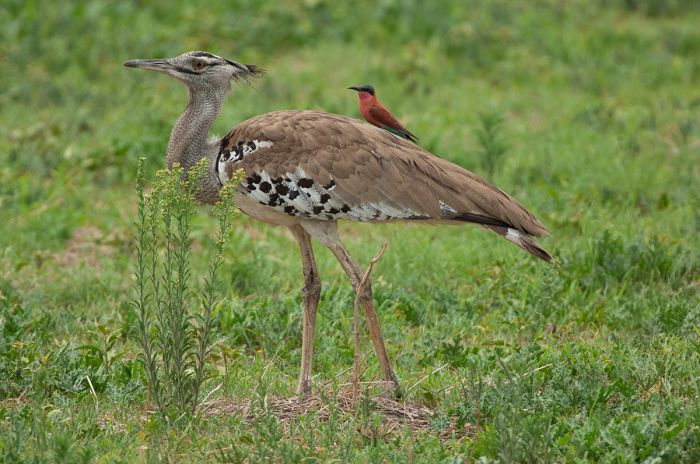
A carmine bee-eater riding atop a kori bustard (Copyright © James Weis).
The permanent water of the Kwando/Linyanti river system provides a haven for the wildlife here, including large numbers of elephant, buffalo, zebra, warthog, red lechwe, greater kudu, giraffe and impala. There are lots of hippos and crocodiles in the waterways and baboons and vervet monkeys live in the forested areas along these rivers.
The are good numbers of leopard, especially in the riparian woodlands along the rivers and channels. Other predators include lion, jackal and spotted hyena. Cheetah are found on the floodplains around the Savuti Channel, Selinda Spillway and Linyanti river. The entire region is one of the best places in Africa to see packs of African wild dogs.
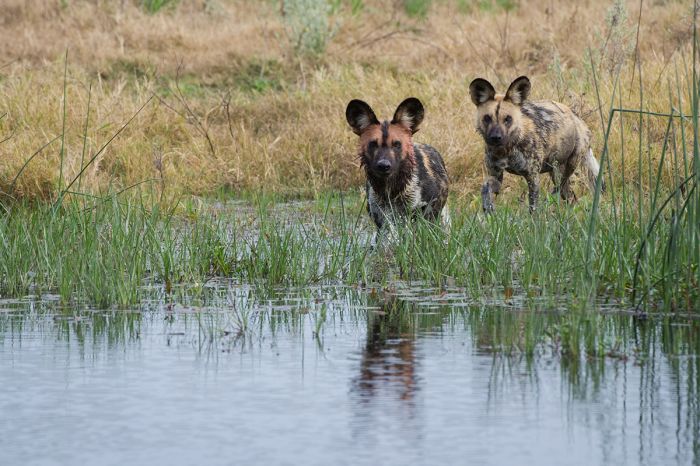
African wild dogs in the Linyanti (Copyright © James Weis).
Chobe National Park
Chobe was Botswana's first proclaimed national park, becoming a game reserve in 1961 and its receiving national park status in 1968. This was a welcome relief for the wildlife, as the land was previously used relentlessly by trophy hunters. Despite its history, today Chobe is still good for game viewing, with numerous lodges located along the riverfront and more far inland around the Savute Marsh.
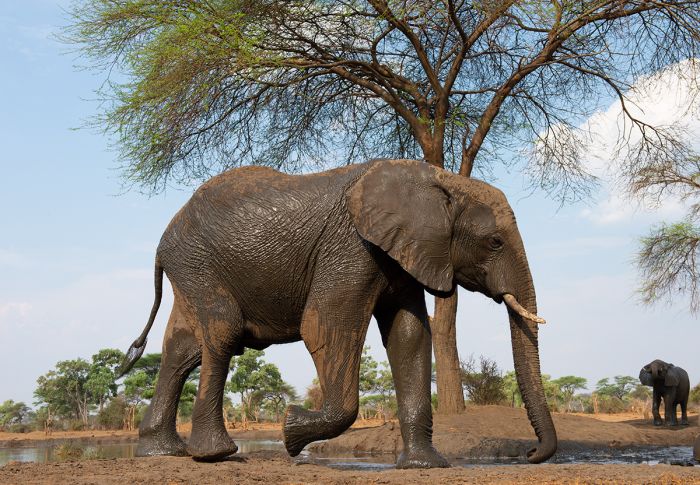
Elephant in Chobe (Copyright © James Weis).
Chobe covers 4 250 square miles (11 700 sq kms) and takes its name from the Chobe River, which forms the park's northern border and separates Botswana from Namibia's Caprivi/Zambezi region.
Much of Chobe is a combination of mixed woodlands and Acacia scrub, but with areas of cathedral mopane tree forest. There are floodplains along the Chobe River and the Savute Marsh is a seasonally wet area that is filled by the sporadically flowing Savute Channel and fluctuating seasonal rainfall.
Chobe sits atop Kalahari Desert sand and there are sand dunes and vegetated sand ridges in various place in the park. Numerous pans are located throughout Chobe (some are pumped), which fill with rain between December and March and provide drinking water for the animals until they dry out.
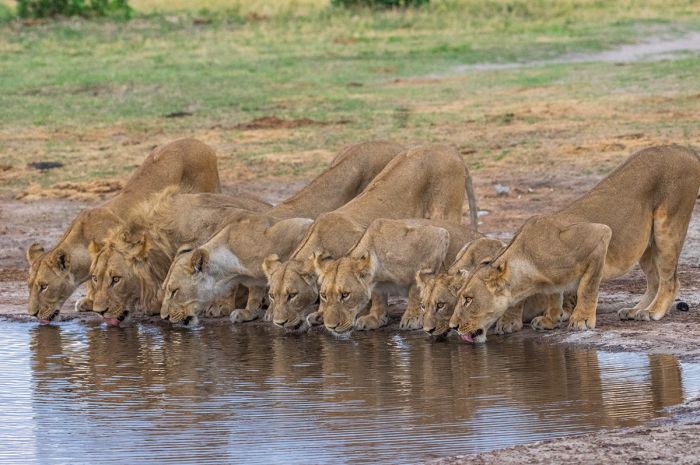
Lions drinking at a waterhole near the Savute Marsh.
Most of Chobe's wildlife is located along the Linyanti/Chobe river system in the far north of the park, particularly during the dry months from July thru October. As the rain abates in March/April, the natural clay pans in the park dry up and the animals, especially elephants and buffalos, are forced to remain near the river for drinking water. The latter part of the dry season is a great time to visit Chobe.
Commonly seen large herbivores in Chobe include elephant, blue wildebeest, Burchell's zebra, giraffe, impala, tsessebe, greater kudu, and warthog. Less common but seen on occasion are eland, roan, and sable antelope.
The most common predators in Chobe are lion and spotted hyena, both of which are seen regularly. African wild dog, cheetah, and leopard are present, but seen less often. Serval, caracal, black-backed jackal, and side-striped jackal are also seen on occasion in Chobe.
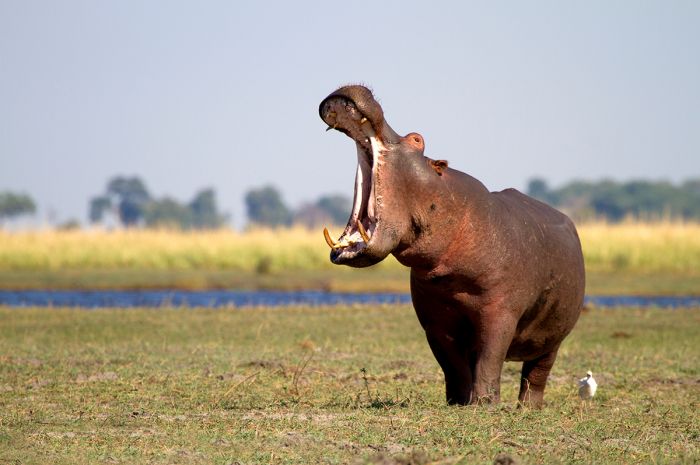
A hippo in a threat posture along the Chobe River, Chobe National Park.
Crocodile and hippo are abundant in the Chobe River. Rhinos originally existed here in large numbers, but were eliminated by hunters and poachers by the 1990s.
Chobe is an excellent birding destination, with a list of around 450 species. The Chobe/Linyanti River system in the north offers a diverse mix of waterbirds, passerines, and raptors. The rest of Chobe, including the Savute Marsh in the south, also offers a good birding experience.
For detailed information on Chobe National Park's two best wildlife destinations, click: Chobe Riverfront and Savute Marsh.
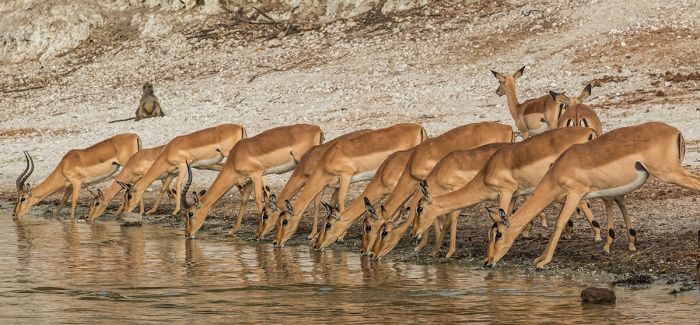
Impalas drinking in Chobe National Park.
CHOBE RIVERFRONT
The Chobe River sustains huge numbers of animals during the dry winter months when the rain water has dried and the permanent river is the only source of water for many miles. Big herds of elephants and buffalos are never far from the river at this time of year. Chobe transforms from a decent safari location most of the year to one of the best places in the country for safaris during the dry months.
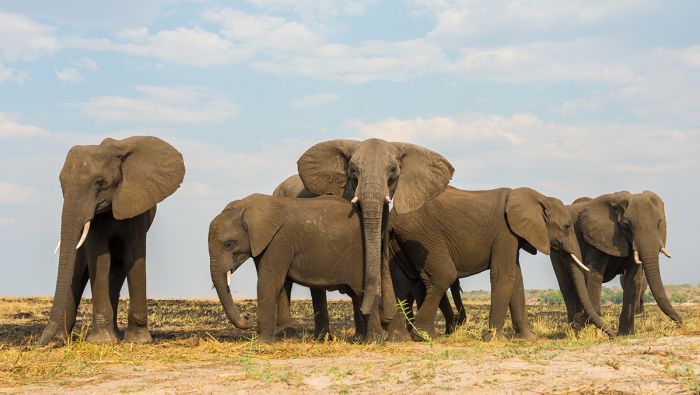
Elephants on the bank of the Chobe River (Copyright © James Weis).
Elephants can often be seen swimming back and forth between the Botswana and the Namibia banks, a spectacular sight! Predators along the river are also common with lions, leopard and wild dogs seen often. Crocodiles and hippos are plentiful in the river and bird life is spectacular, with herons, egrets, fish eagles, skimmers, pelicans and kingfishers seen everywhere along the banks.
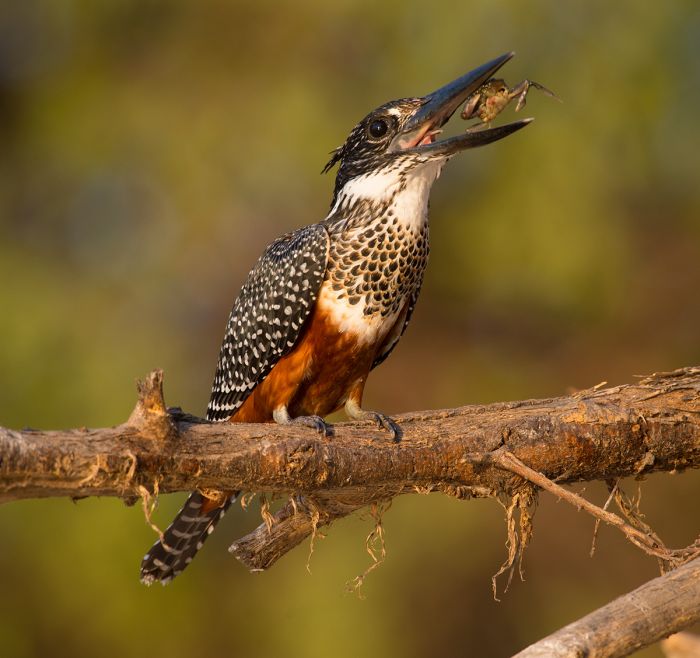
Giant kingfisher on the Chobe River (Copyright © James Weis).
Savute Marsh
While most of Chobe National Park away from the Chobe River is thick scrub bush on sandy terrain, the area around the Savute Marsh has rich grasslands and wooded forest. The Savuti Channel, which originates in the northern Linyanti, flows with drastically variable amounts of water and empties (when there is enough water) into the Savute Marsh, giving life to this otherwise dry region.
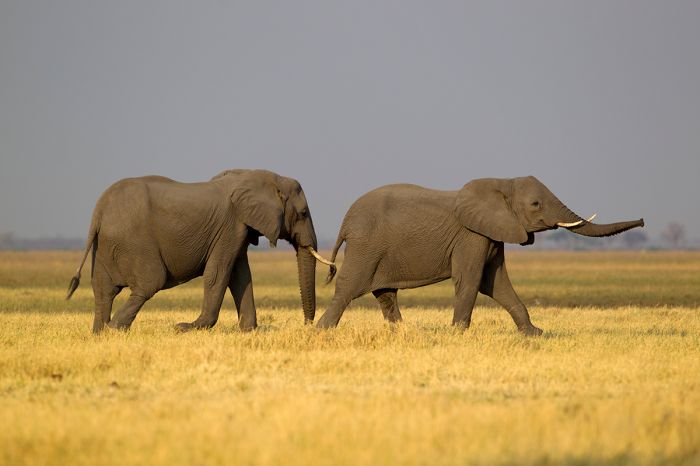
Elephants in the Savute Marsh area of Chobe National Park.
Over the years, the Savute Marsh has cycled from years of dry to years of wet, depending entirely on the amount of water entering the Savuti Channel. The skeletons of dead trees can be seen around the marsh, many of them leadwood trees, which can stand many years after dying. These remnants are thought to be from trees that grew between the 1880s and 1950s, when the marsh was dry and subsequently died when the marsh flooded again in the late 1950s.
Today there are several permanent waterholes (filled via water pumps) and the wildlife around them is plentiful, as they are the only permanent water for many miles for most of the year. Two permanent safari camps and several overland campsites are situated around the marsh.
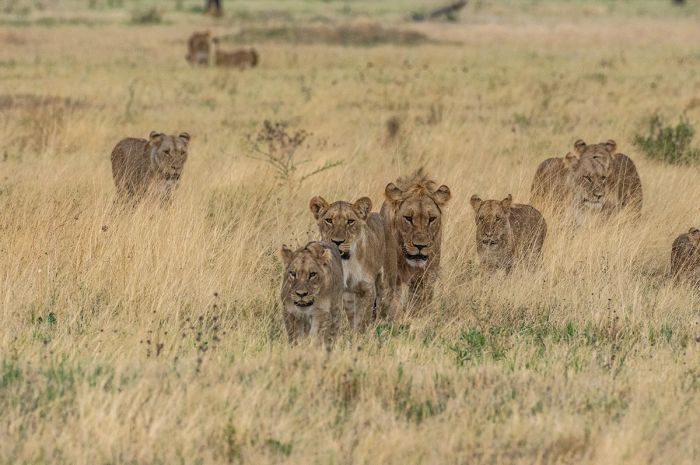
Lion pride on the move at the Savute Marsh.
The Savute Marsh is well known for its lion prides, some of which grew so large that they took to killing elephants to satisfy their needs. Herds of elephants frequently pass through the area on their way to and from the Okavango. There are also very impressive bull elephants that live in the marsh for much of the year. Leopards do well around the marsh, with rocky outcrops and small forest pockets giving them refuge and spotted hyenas are common, with several large clans competing for the abundant prey.
During and just after the rainy months, wildebeest and zebra move through the marsh for the fresh grasses, especially during April and May. Buffalo herds can also seen when the Savuti Channel is flowing. Giraffes are present on the southern side of the marsh in the acacia woodland and sometimes oryx can be seen here. Birdlife is exceptionally good, especially when the marsh has water.
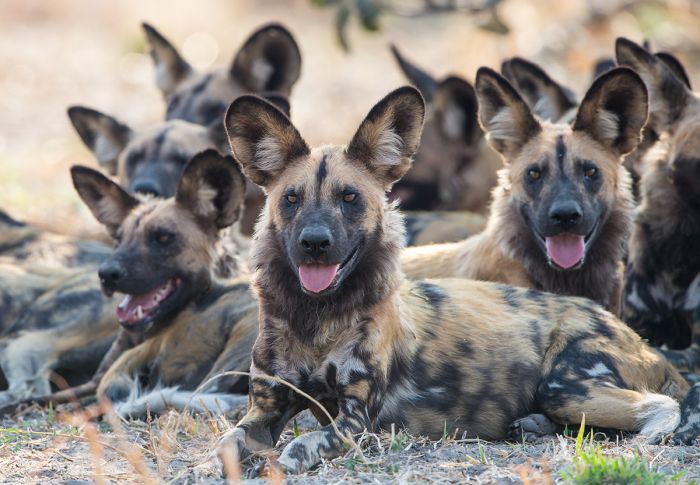
African wild dogs in the Savute Marsh, Chobe National Park.
Read More...
Chobe National Park, Chobe Riverfront, Kwando, Linyanti, Northern Reserves, Savute Marsh, Selinda
Great Good Fair Poor
- Jan
- Feb
- Mar
- Apr
- May
- Jun
- Jul
- Aug
- Sep
- Oct
- Nov
- Dec
Summer / Green Season
Northern Botswana receives the majority its rainfall from December thru March. November and December experience only occasional rainstorms, while January and February can see heavy afternoon downpours most days, with all-day rain uncommon. By mid-March, the rainfall is decreasing, but some storms are possible. Mornings become cooler by the end of March.
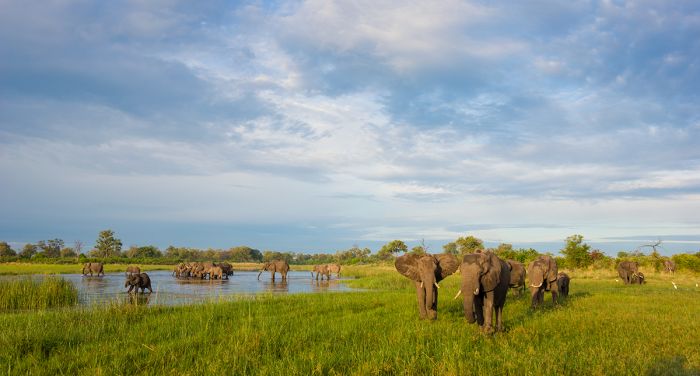
Elephants enjoy the verdant landscape in December (Copyright © James Weis).
The rains tend to keep temperatures from becoming overly hot, although humidity and insect life are at their peak. Days are mostly overcast or partially cloudy, with dramatic skies and a verdant color to the landscape. Afternoon temps average highs of 88°F (31°C), while mornings are very comfortable at around 65°F (19°C).
The green season is wonderful for photography, with baby animals in abundance, and thousands of migratory birds here for breeding. The ground is lush and green, the skies overcast and often dramatic, and the lagoons and pans are full of water and life.
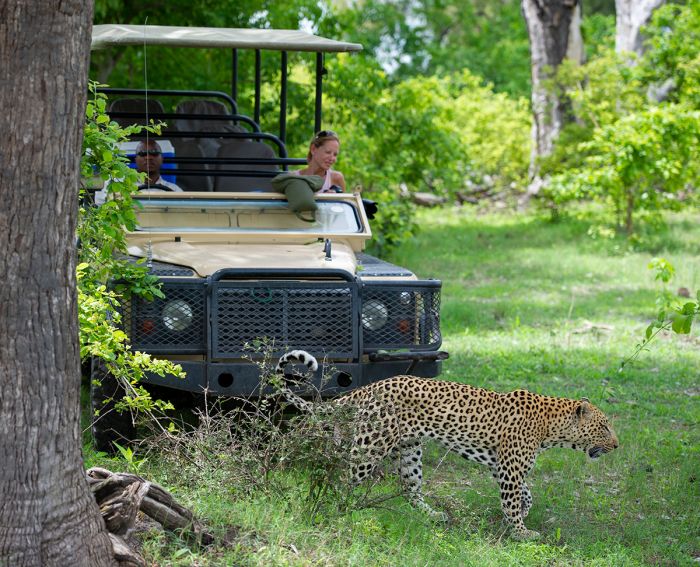
Watching a leopard hunting during the Green Season (Copyright © James Weis).
Unlike the winter months, when middays are hot and animals typically seek shade from around 10am til mid-afternoon, the cloudy skies in the summer often mean that animals are active throughout the day, offering many more hours of game viewing.
Winter / Dry Season
The dry months of June through October are spectacularly good for safaris.
Most of the rain water is evaporating, but flood water is arriving via the rivers from Angola and the lagoons and rivers are rising. The surrounding landscape is drying and airborne sand and dust is increasing, making for some spectacular sunsets.
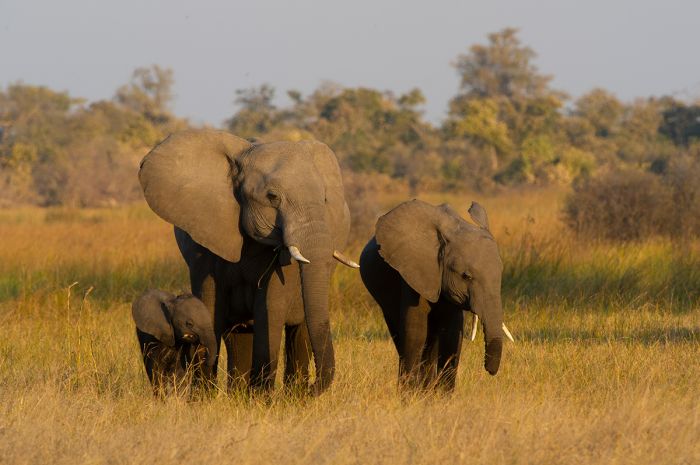
Elephants and July's winter landscape (Copyright © James Weis).
Game viewing is at its peak, with animals remaining close to the permanent water sources. Mornings are cold at around 45°F (7°C). Warm clothes, including winter hat and gloves are needed for the open-air game drives. Dress in layers, as the temps do rise quickly during the day, with middays reaching 79°F (26°C).
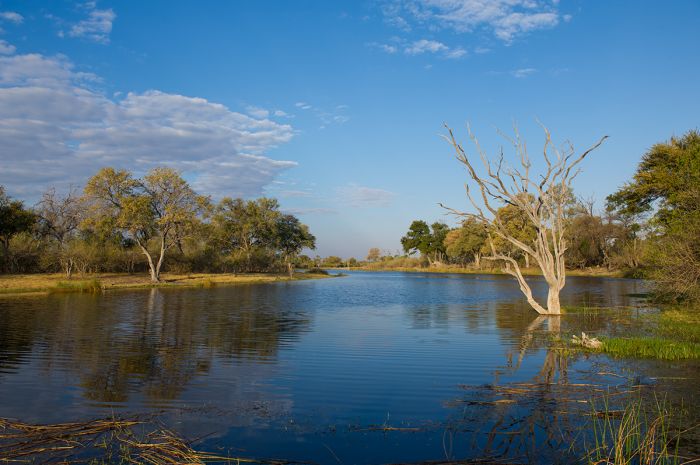
The Savuti Channel in July (Copyright © James Weis).
Chobe Riverfront
Great Good Fair Poor
- Jan
- Feb
- Mar
- Apr
- May
- Jun
- Jul
- Aug
- Sep
- Oct
- Nov
- Dec
Safaris on the Chobe River are best during the dry season months (July-October), with abundant wildlife remaining close the the river until the first rains arrive (usually sometime in November). Large herds of elephant and buffalo, as well as numerous other herbivores, can be seen along the river banks and the game viewing is superb.
Once the rains begin, the animals move away from the river, as rainwater is plentiful and food sources are better away from the river.
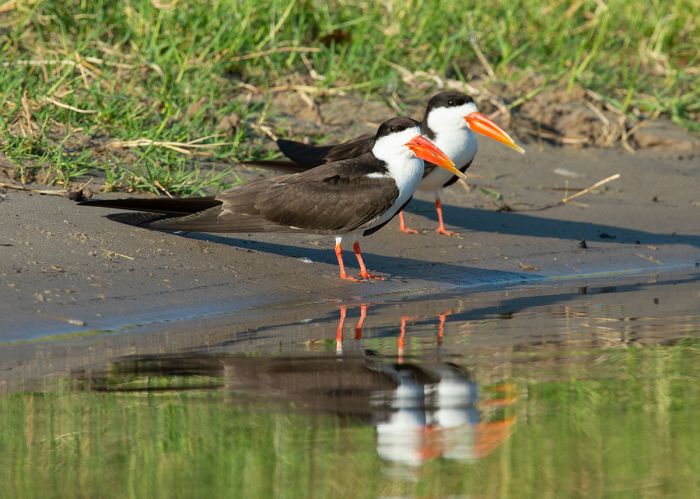
African skimmers and Chobe River in October (Copyright © James Weis).
Showing 1–13 of 13 results
Offers an authentic and rustic safari experience in a small camp with meals cooked over an open fire. Located on the Chobe Riverfront, which attracts huge numbers of animals during the dry winter season. Game drives and boating.…
Located in the Linyanti Reserve on the banks of a large lagoon, DumaTau Camp offers day and night safari drives, seasonal walking, and boating. The area is superb for wildlife, particularly during the dry season.…
Located in a wildlife-rich location overlooking the Linyanti River, the camp offers day and night safari drives, seasonal walking, and boating. The area is well known for predators and elephants.…
A small, remote, classic-style camp located in a private concession on the bank of the Linyanti River. Abundant wildlife, especially during the dry season. Day and night game drives, bush walks, mokoroing, scenic helicopter flights, and cultural visits.…
Small, intimate, classic-style, tented camp located in a private concession on the bank of the Linyanti River. Very good wildlife viewing, especially during the dry season. Day and night game drives, bush walks, mokoroing, scenic helicopter flights, and cultural visits.…
A small, seasonal, classic-style, tented camp that evokes safaris from the days of early explorers of this wild region, but with modern day comforts. Located in a private concession on the bank of the Linyanti River. Open only during the dry season, when wildlife viewing is best.…
This small classic-style camp is reminiscent of the early days of safari in Botswana. Ideal for families or small groups. Superb wildlife viewing during the dry season. Offers safari drives, seasonal walking, and a log-pile hide.…
Little DumaTau is an intimate 4-tented camp which adjoins the larger DumaTau Camp in the Linyanti Reserve. The camp offers day and night safari drives, boating, and seasonal nature walks. The are teems with wildlife during the dry season.…
Offers an authentic and rustic safari experience in a small camp with meals cooked over an open fire. Located in the Savute Marsh, which attracts wildlife all year, including the summer migration of zebra and wildebeest.…
Located in the Linyanti Reserve on the banks of the Savuti Channel, which fluctuates between dryness and a flowing river. The camp offers classic accommodation, with day and night safari drives, seasonal walking, and water-dependent boating.…
Small and exclusive safari camp in a wildlife-rich, wilderness setting. Luxurious guest suites, excellent service and cuisine. Game drives, walking, boating, canoeing, fishing.…
Small and romantic camp modeled after the luxury mobile camps used by Africa's early explorers, but with modern-day conveniences and hospitality. Located in a wilderness area teeming with wildlife. Game drives, walking, canoeing, fishing.…




